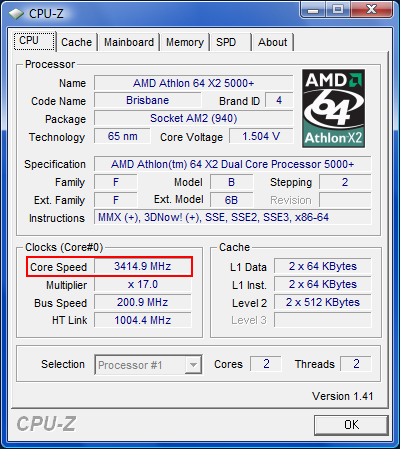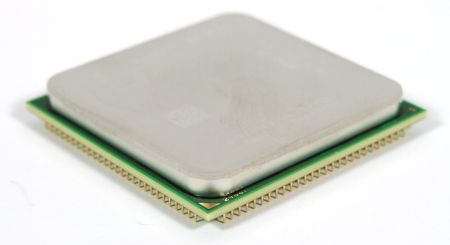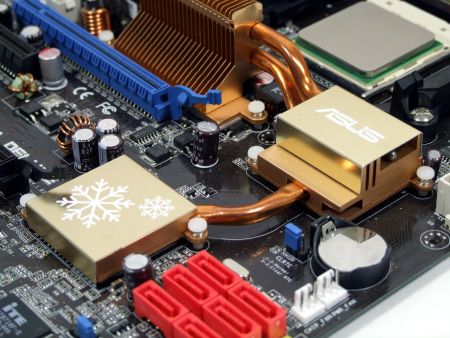AMD's Athlon 64 X2 5000+ Black Edition
End Of The Line At 3.40 GHz
We continued to increase the core voltage, first to 1.475 V and then to 1.500 V.
We were able to boot the system at 3.40 GHz without a problem, and even run several benchmarks, but not all of them. At this speed, Prime95 - our standard when it comes to stability tests - would not complete its test run without errors.
If you use a water-cooling system, you may be able to reach higher frequencies still, since the core temperature is much lower than using normal air-cooling, giving the core a little more overclocking headroom.
A side view of the Athlon 64 X2 5000+ Black Edition.
When we tried increasing the clock speed beyond 3.4 GHz, the system crashed immediately.
Since the front-side bus is not overclocked, the chipset does not require additional cooling.
As the final entry in our overclocking logbook, we present you with a table detailing the combinations of multipliers, voltages and memory speeds of our overclocking tests with the 5000+ Black Edition:
Get Tom's Hardware's best news and in-depth reviews, straight to your inbox.
| Overclocking Logbook | |||
|---|---|---|---|
| Frequency | Voltage | Memory | Multiplier |
| 2.60 GHz | Standard | DDR2-743 | 13x |
| 3.10 GHz | Standard | DDR2-775 | 15.5x |
| 3.20 GHz | 1.400 V | DDR2-800 | 16x| |
| 3.30 GHz | 1.450 V | DDR2-733 | 16.5x |
| 3.40 GHz | > 1.475 V | DDR2-755 | 17x |
The last of the four Black Edition stickers.
Current page: End Of The Line At 3.40 GHz
Prev Page 3.30 GHz At 1.450 V Next Page Only 75 Watts At 3.10 GHzTom's Hardware is the leading destination for hardcore computer enthusiasts. We cover everything from processors to 3D printers, single-board computers, SSDs and high-end gaming rigs, empowering readers to make the most of the tech they love, keep up on the latest developments and buy the right gear. Our staff has more than 100 years of combined experience covering news, solving tech problems and reviewing components and systems.
-
gowens what kind of cooling system is needed to overclock to 3.1 Ghz? I'm buying a barebones kit with this CPU but no heatsink/fan.Reply -
Cursedeyes this article is very helpful, but my bios lets me increase the cpu voltage in increments of 5 mV up to 600mV . so how much to i out it up in order to equal 1.450 V?Reply -
Koshi This article was helpful in making my decision to buy this processor, but I have a problem when overclocking it (first time overclocking). My pheonix award bios on my m2n sli board wont let me increase the cpu voltage past 1.325, and I want to know if there's anyway I can increase it. I can only get to 14.5x multiplier at this voltage.Reply -
Hi,Reply
Great article. I am new to OC, and have the 5000+ Black Edition and I am running it in an Asus M2N-SLI with a Zerotherm Butterfly CPU cooler. CPU according to HWMonitor, Core 0 is running at about 18C and Core 2 is at about 19 so heat shouldn't be a problem. Memory currently is Patriot 1GB PC2 5300 667mhz but in a couple days I will be adding 4 GB of OCZ SLI Ready Edition Dual Channel DDR2 800 Mhz . My question, is will the 667 Patriot memory that I currently have work if I overclock to 3.0, and would the OCZ 800 be adequate to OC to 3.2 ?
Second, I've not done this before, from what I can gather here I can just change the multiplier in BIOS without messing with voltages if I don't go beyond 3.1 which would be achived by using a 15.5 multiplier.
Thanks for the information here and any tips...
**agroberts@knology.net** -
hellspawnpr I have this CPU , been very happy with it so far. I have it at 3.2ghz running smoothly. I put a gigabyte GIGABYTE GH-PDU22-SC EVR Sleeve CPU Cooler only cost 23.00 has my cpu at 32c idleReply -
Skiscola I can only get mine to a 14.5 multiplier I have a M2N-SLI Deluxe MOBO,CORSAIR XMS2 2GB (2 x 1GB) 240-Pin DDR2 SDRAM DDR2 800 (PC2 6400) Dual Channel Kit Desktop Memory X2 for 4 GB, Thermaltake CL-P0075 80mm 2 Ball CPU Cooling Fan/Heatsink. How can i get it higher without it crashingReply -
Darkerson And to think i passed this one up for a 5200+, for some god awful reasoning at the time. Ah, the good old days!Reply




